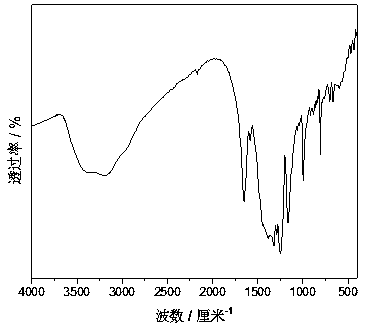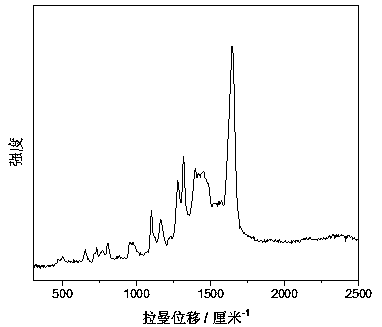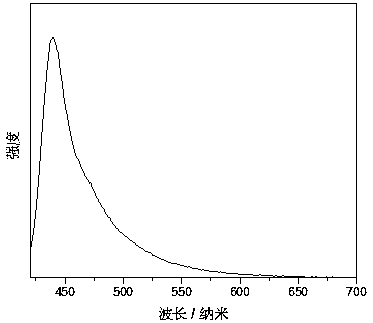Preparation method and use of crystal phase carbon nitride nano-particles
A technology of crystalline phase carbon nitride and phase carbon nitride, which is applied in the field of preparation of crystalline phase carbon nitride nanoparticles, can solve the problems of low crystallinity, large particles, incomplete polymerization, etc., and achieves low cost and low energy consumption. , the effect of large application potential
- Summary
- Abstract
- Description
- Claims
- Application Information
AI Technical Summary
Problems solved by technology
Method used
Image
Examples
Embodiment 1
[0028] Firstly, 2 g of dipolycyanamide was weighed and placed in an alumina crucible with a lid, and calcined for 2 h in an air atmosphere at a temperature of 400° C. After natural cooling, the sample was taken out and ground into powder to obtain bulk carbon nitride powder. Weigh 0.5g of bulk carbon nitride powder and 20g of molten salt (a mixture of potassium chloride and lithium chloride) to grind evenly, and calcinate at 600°C for 2 hours in a nitrogen atmosphere, and the solid obtained after natural cooling is ultrasonically dispersed in water. Suction filtration and drying to obtain crystalline carbon nitride. Weigh 0.2 g of crystalline carbon nitride, reflux in 100 mL of 0.1 M sodium hydroxide solution for 12 h, and dialyze to remove the supernatant to obtain crystalline carbon nitride nanoparticles.
Embodiment 2
[0030] Firstly, 4 g of melamine was weighed and placed in an alumina crucible with a lid, and calcined for 4 h in a nitrogen atmosphere at a temperature of 500° C. After natural cooling, the sample was taken out and ground into powder to obtain bulk carbon nitride powder. Weigh 0.2g of bulk carbon nitride powder and 20g of molten salt (a mixture of potassium bromide and lithium bromide) to grind evenly, calcinate in a nitrogen atmosphere at 500°C for 2h, and the solid obtained after natural cooling is ultrasonically dispersed in water and removed by centrifugation The supernatant was then dried to obtain crystalline carbon nitride. Weigh 0.2 g of crystalline carbon nitride, reflux in 100 mL of 0.1 M potassium hydroxide solution for 12 hours, and centrifuge to remove the supernatant to obtain crystalline carbon nitride nanoparticles.
Embodiment 3
[0032] Firstly, 20 g of urea was weighed and placed in an alumina crucible with a cover, and calcined for 4 h in an air atmosphere at a temperature of 400° C. After natural cooling, the sample was taken out and ground into powder to obtain bulk carbon nitride powder. Weigh 2g of bulk carbon nitride powder and 20g of molten salt (a mixture of potassium chloride and lithium chloride), grind them evenly, and calcinate them at 600°C for 2 hours in a nitrogen atmosphere. Filter and dry to obtain crystalline carbon nitride. Weigh 0.2 g of crystalline carbon nitride, reflux in 100 mL of 0.1 M sodium hydroxide solution for 12 h, and then dialyze to remove the alkali solution to obtain crystalline carbon nitride nanoparticles.
[0033] figure 1 It is the Fourier transform infrared spectrogram of the crystalline carbon nitride photon nanoparticles obtained in Example 1. 800cm in the picture -1 and 1000~1700cm -1 The signals in the interval correspond to the breathing vibration of t...
PUM
| Property | Measurement | Unit |
|---|---|---|
| Particle size | aaaaa | aaaaa |
Abstract
Description
Claims
Application Information
 Login to View More
Login to View More - R&D
- Intellectual Property
- Life Sciences
- Materials
- Tech Scout
- Unparalleled Data Quality
- Higher Quality Content
- 60% Fewer Hallucinations
Browse by: Latest US Patents, China's latest patents, Technical Efficacy Thesaurus, Application Domain, Technology Topic, Popular Technical Reports.
© 2025 PatSnap. All rights reserved.Legal|Privacy policy|Modern Slavery Act Transparency Statement|Sitemap|About US| Contact US: help@patsnap.com



